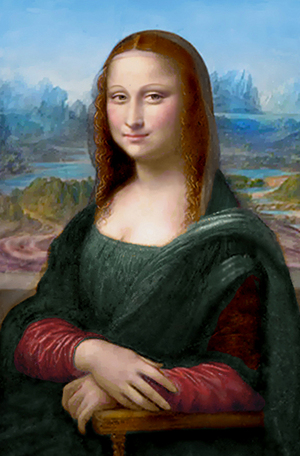The astonishing brilliance of color and subtlety of modeling in Leonardo da Vinci’s Mona Lisa has been revealed by a remarkable combination of art and science. Sophisticated computer imaging, application of color filters and tonal adjustments were applied in this completely original digital restoration by the author to reproduce the appearance of the original work of art in Leonardo’s time.
The digital restoration here is based on a comprehensive study of Renaissance-painting techniques and materials, and comparative adaptation to early verified copies that are still in excellent condition today. You can now see the rosy flesh tones and dazzling hues that so impressed Leonardo’s contemporaries. Details are revealed, such as the armrest of the chair on which her forearm is placed.
Descriptions of the painting by Georgio Vasari, an art historian of the Renaissance, mention the highly detailed realism, including individual eyebrow hairs and eyelashes as well as the the natural sheen on the surface of the eye. He mentions also the pearly tints of the surrounding canvas areas. A significant portion of his description dwells on the rosy aspect of the skin tones, and maintains that it is more like real flesh than pigment.
He suggests that one may even be able to discern the beat of a pulse in the Mona Lisa’s throat. Compare the work by Leonardo’s contemporary, Raphael, the well-preserved Portrait of Maddalena Doni, inspired directly by the Mona Lisa. In it you can see the vivid colors and naturalistic flesh tones that the Renaissance Masters achieved. (link to image) Yet, Leonardo da Vinci was considered the great master of the era.
.
Why then does the ‘Lady of the Louvre’ have such a dull, monochromatic appearance today? When exposed to light, air and humidity, pigments age and darken over time, and the mixed oil resins will yellow and loose transparency with age. Restorative efforts included overcoats of varnish that also darkened the overall tone. Subtle details such as the eyebrows and eyelashes, painted with pigments mixed from organic dyes, have faded. The vivid reds and greens of the silk and satin garments, which were achieved by layered oil glazing have darkened into tones of deep brown and greenish black.
The color of the Mona Lisa’s sleeves in da Vinci’s original were red, as shown in the verified Renaissance copy known as La Giaconda (image link). The upper portion of the lustrous red sleeves show through the lacy mantle. The dress is a contrasting deep forest green with elaborate brocades. Included here also are the subtle patterns of the sheer lace veil that stands out from the hair at the edge of her face. Mona Lisa‘s hair and eyes are depicted in rich chestnut hues with golden highlights.
A notable feature in the Mona Lisa, according to early written accounts, was the magnificent landscape of the background. Below a brilliant blue sky was a series of verdant foothills receding to lofty, snow covered peaks shrouded in mist. In this restoration we can see the atmospheric perspective that lends volumetric form to the foreground and a deep dimension to the painting as a whole. Visible also are the stone window sills, in front of which the Mona Lisa sits.
Recent commentary on other reproductions that are based on scanned imagery include a suggestion that the Mona Lisa holds a blanket that has all but faded from view. However, it is clear in the digital restoration pictured here that the left arm is resting on a plain wooden armrest with a lathed upright support. The fingers of the hand are limp and relaxed, touching the edge of the armrest, and clearly not gripping or holding anything.
The corroborated research and evidence referenced here reveal the best currently available visual representation of the original brilliance of color, depth of perspective, and subtlety of modeling achieved by Leonardo.
Sources:
Giorgo Vasari, Lives of the Painters, Sculptors and Architects, G. Du C de Vere, translation by D. Ekserdian, New York, 1996
http://content.answers.com/main/content/wp/en-commons/thumb/c/cc/300px-Raffael_036.jpg
http://www.scholarsresource.com/images/thumbnails/192/l/lif0426.jpg
